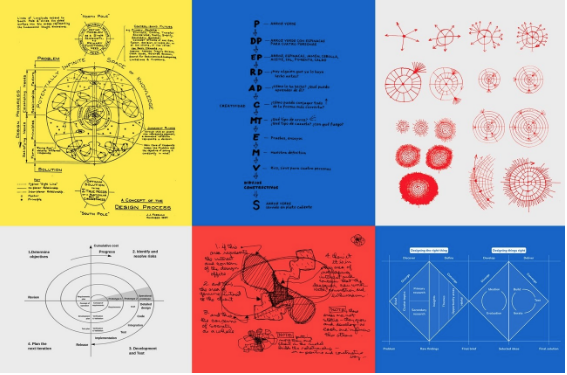Project and temporality. An analysis of design method between survival and/or utopia
DOI:
https://doi.org/10.46516/inmaterial.v9.195Keywords:
design, methods, projects, time, latenciesAbstract
Methods in design attempt to guide and prevent projects from deviating from planned trajectories. For the sake of efficiency, productive dynamics involve temporalities that can hinder the perception or creation of non-linear models that often prove to be more fertile, yet on different scales and with different objectives.
The chrono-logical conception of time fuels the desire to resolve any project, an issue that is evident in its pressing terminology, with words such as phase, stage, sprint, timeline or deadline, terms with a mercantile tinge that, in turn, permeate the teaching environment and become grades, competencies, credits, deliverables, results or evaluations. The confluence of these models with digital tools has spurred the speed with which work is done as opposed to slow reflection, favouring an exhausting determinism. Everything must be completed and closed on time.
The article reopens the debate that has historically explored the potential of design between commodity and utopia. To do so, it analyses cases that bring together different design disciplines and their teaching (Bauhaus, HfG Ulm, Black Mountain College, Victor Papanek, Buckmister Fuller, Enzo Mari, Bruno Munari, Ray and Charles Eames) in order to identify the conceptions of time they integrate, in order to discern how they affect the ways of proceeding and the policies they champion. In short, the ways of doing and being in and with the world. An ethical background that appeals to the designer's relationship with work, between perceptions that tend to consider the project as concluded and others that consider the project as a living organism in continuous transformation (of the world and of oneself).
Downloads
References
Bass, J. and Kirkham, P. (2011) "Saul Bass: a life in film & design". London: Laurence King.
Bender, J.B. and Marrinan, M. (2010) "The culture of diagram." Stanford, Calif: Stanford University Press.
Boehm, B. et al. (2014) "The Incremental Commitment Spiral Model Principles and Practices for Successful Systems and Software." Sydney: Pearson Education, Limited.
Brady, M. and Leal, J. (2011) "Wim Wenders and Peter Handke: collaboration, adaption, recomposition." Amsterdam; New York: Rodopi (Internationale Forschungen zur allgemeinen und vergleichenden Literaturwissenschaft, 147).
"Bruno Munari" (2022). Fundación Juan March.
De Boever, A. (ed.) (2012) "Gilbert Simondon: being and technology. "Edinburgh: Edinburgh University Press.
Díaz, E. (2014) "The Experimenters: Chance and Design at Black Mountain College." University of Chicago Press. https://doi.org/10.7208/chicago/9780226068039.001.0001.
Eames, C. and Eames, R. (2016) "The world of Charles and Ray Eames." Edited by C. Ince and L. Johnson. New York: Rizzoli.
Esquirol i Calaf, J.M. (2009) "El respirar dels dies: una reflexió filosòfica sobre el temps i la vida." Barcelona: Paidós.
García-Estevez, C.B. (2022) "Pedagogías Bauhaus. "Edited by E. Prieto and S. Guerrero López. Madrid: EdicionesAsimétricas.
Illouz, E. and Sicron, A. (2023) "The emotional life of populism: how fear, disgust, resentment, and love undermine democracy." Medford: Polity Press.
Jones, J.C. (1982) "Métodos de diseño." 3a ed. ampliada. España: Gustavo Gili.
Kahneman, D. (2017) "Pensar rápido, pensar despacio". Sexta edición. Translated by J. Chamorro. Barcelona: Debols!llo.
Kepes, G. (1995) "Language of vision". New York: Dover.
Kubler, G. (2008) "The shape of time: remarks on the history of things." paperback ed. New Haven, Conn.: Yale University Press.
Kuhn, T.S. (2004) "La estructura de las revoluciones científicas." México, D.F.: Fondo de Cultura Económica.
Kunst, B. (no date) "The Project Horizon: On the Temporality of Making", p. 3.
Latour, B. (1990) ‘Technology is Society Made Durable’, The Sociological Review, 38(1_suppl), pp. 103–131. https://doi.org/10.1111/j.1467-954X.1990.tb03350.x.
Maldonado, T. (2021) "Bauhaus." Barcelona: Anagrama (Argumentos, 561).
Mari, E. (2010) "Autoprogettazione? "2. ristampa. Mantova: Corraini.
Mari, E. and Orts, P. (2021) "Proyecto y pasión." Barcelona: Gustavo Gili.
Marzo, J.L. (2021) "Las videntes: imágenes en la era de la predicción. Barcelona: Arcàdia.
"Meseguer, A. (2002) “Espacio y tiempo, lengua y realidad” Centro Virtual Cervantes.
URL: https://cvc.cervantes.es/el_rinconete/anteriores/septiembre_02/02092002_02.htm [Consultado 15/01/2024]
Munari, B. (2014) "Diseño y comunicación visual: contribución a una metodología didáctica." 1ª ed., 18ª tirada. Barcelona: Gustavo Gili.
Munari, B. (2021) "¿Cómo nacen los objetos?: apuntes para una metodología proyectual." Segunda edición, 2016. Barcelona: GG.
Munari, B. and Orts, P. (2019) "Artista y diseñador." Barcelona: Editorial Gustavo Gili, SL.
Obrist, H.U. et al. (eds) (2020) "Enzo Mari" Milano: Electa.
Ottenheimer, H. (2009) "The anthropology of language: an introduction to linguistic anthropology". 2nd ed. Belmont, CA: Wadsworth.
Papanek, V. (2014) "Diseñar para el mundo real: ecología humana y cambio social." 2ª ed. Barcelona: Pol·len.
Suska, A. (2023) “Design Process Step by Step | Double Diamond Model Explained” Bootcamp. URL:https://miro.medium.com/v2/resize:fit:4800/format:webp/1*kJYrXVdqWqWPBqv6EdAQOw.png [Consultado 10/01/2024]

Published
Versions
- 2024-12-20 (2)
- 2025-01-22 (1)
How to Cite
Issue
Section
License
Copyright (c) 2024 Nicolas Juárez Latimer-Knowles

This work is licensed under a Creative Commons Attribution-ShareAlike 4.0 International License.






